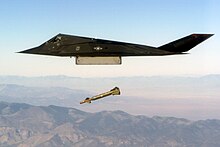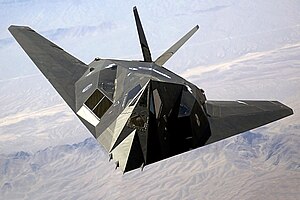Indonesian Space Force Command
(Komando Angkatan Antariksa Indonesia)
F-117 Nighthawk
F-117A Nighthawk "Stealth Fighter"
| F-117 Nighthawk | |
|---|---|
| Role | Stealth attack aircraft[1] |
| National origin | United States |
| Manufacturer | Lockheed Corporation Lockheed Martin |
| First flight | 18 June 1981 |
| Introduced | 15 October 1983 |
| Retired | 22 April 2008[2] |
| Primary user | United States Air Force |
| Number built | 64 (5 YF-117A, 59 F-117A) |
| Unit cost | US$42.6 M (flyaway cost) US$111.2 M (total program)[3] |
| Developed from | Lockheed Have Blue |
The F-117A Nighthawk is the world's first operational aircraft designed to exploit low-observable stealth technology. The unique design of the single-seat F-117A provides exceptional combat capabilities. About the size of an F-15 Eagle, the twin-engine aircraft is powered by two General Electric F404 turbofan engines and has quadruple redundant fly-by-wire flight controls. Air refuelable, it supports worldwide commitments and adds to the deterrent strength of the U.S. military forces.
The F-117A can employ a variety of weapons and is equipped with sophisticated navigation and attack systems integrated into a state-of-the-art digital avionics suite that increases mission effectiveness and reduces pilot workload. Detailed planning for missions into highly defended target areas is accomplished by an automated mission planning system developed, specifically, to take advantage of the unique capabilities of the F-117A.
Streamlined management by Aeronautical Systems Center, Wright-Patterson AFB, Ohio, combined breakthrough stealth technology with concurrent development and production to rapidly field the aircraft. The F-117A program has demonstrated that a stealth aircraft can be designed for reliability and maintainability. The aircraft maintenance statistics are comparable to other tactical fighters of similar complexity. Logistically supported by Sacramento Air Logistics Center, McClellan AFB, Calif., the F-117A is kept at the forefront of technology through a planned weapon system improvement program located at USAF Plant 42 at Palmdale, Calif. The Air Force thinking today is that it will phase out the Nighthawks after 2018.
The first F-117A was delivered in 1982, and the last delivery was in the summer of 1990. The F-117A production decision was made in 1978 with a contract awarded to Lockheed Advanced Development Projects, the "Skunk Works," in Burbank, Calif. The first flight was in 1981, only 31 months after the full-scale development decision. Lockheed-Martin delivered 59 stealth fighters to the Air Force between August 1982 and July 1990. Five additional test aircraft belong to the company.
Air Combat Command's only F-117A unit, the 4450th Tactical Group, achieved operational capability in October 1983. Since the F-117’s first Air Force flight in 1982, the aircraft has flown under different unit designations, including the 4450th Tactical Group and the 37th Tactical Fighter Wing at Tonapah Test Range, NV; the 57th Fighter Weapons Wing, Nellis AFB, NV; the 410th Flight Test Squadron/410th Test Squadron, Palmdale, CA; and Detachment 1, Test Evaluation Group, also at Holloman, which falls under the 53rd Wing, Eglin AFB, FL.
The stealth fighter emerged from the classified world while stationed at Tonapah Airfield with an announcement by the Pentagon in November 1988 and was first shown publicly at Nellis in April 1990. The 4450th TG was deactivated in October 1989, and was reactivated as the 37th Tactical Fighter Wing.
In 1992 the F-117A Nighthawk made its new home at Holloman Air Force Base. The official arrival ceremony for the F-117 to Holloman AFB was conducted 09 May 1992. The 49th Fighter Wing (49FW) at Holloman serves as the only F-117 Home Station. The 49th Operations Group operates and maintains the F-117A aircraft. The 7th CTS "Screamin' Demons" serves as the transition training unit, preparing experienced Air Force pilots for assignment to the F-117A Nighthawk. The 8th and 9th Fighter Squadrons are designated to employ the F-117A Nighthawk in combat. Once an F-117 pilot has successfully completed training, he is then assigned to one of only two operational Nighthawk squadrons--the 8th FS "Black Sheep" and the 9th FS "Flying Knights." The 49FW provides full compliment of flightline maintenance capabilities as well as back-shop support. The F-117 deploys in support of contingency operations, as directed by National Command Authorities. Flightline maintenance support is deployed concurrent with the aircraft. Depending on the deployment duration, varying levels of back shop maintenance support may also be deployed.
The F-117A first saw action in December 1989 during Operation Just Cause in Panama.
The stealth fighter attacked the most heavily fortified targets during Desert Storm (January-February 1991) , and it was the only coalition jet allowed to strike targets inside Baghdad's city limits. The F-117A, which normally packs a payload of two 2,000-pound GBU-27 laser-guided bombs, destroyed and crippled Iraqi electrical power stations, military headquarters, communications sites, air defense operation centers, airfields, ammo bunkers, and chemical, biological and nuclear weapons plants.
Although only 36 stealth fighters were deployed in Desert Storm and accounted for 2.5 percent of the total force of 1,900 fighters and bombers, they flew more than a third of the bombing runs on the first day of the war. In all during Desert Storm, the stealth fighter conducted more than 1,250 sorties, dropped more than 2,000 tons of bombs, and flew more than 6,900 hours. More than 3,000 antiaircraft guns and 60 surface-to-air missile batteries protected the city, but despite this seemingly impenetrable shield, the Nighthawks owned the skies over the city and, for that matter, the country. The stealth fighter, which is coated with a secret, radar-absorbent material, operated over Iraq and Kuwait with impunity, and was unscathed by enemy guns.
In the opening phase of Allied Force, aimed primarily at Yugoslavia's integrated air defense system, NATO air forces conducted more than 400 sorties. During the first two night attacks, allied troops in the air and at sea struck 90 targets throughout Yugoslavia and in Kosovo. F-117 Nighthawks from the 8th Expeditionary Fighter Squadron at Holloman Air Force Base NM participated in air strikes against targets in the Balkans during NATO operations. One F-117 fighter was lost over Yugoslavia on 27 March 1999. A US search and rescue team picked up the pilot several hours after the F-117 went down outside Belgrade. On 01 April 1999, Defense Secretary William Cohen directed 12 more F-117 stealth fighters to join NATO Operation Allied Force, to join the total of 24 F-117s that were participating in NATO Operation Allied Force.
Among the penalties for stealth are lower engine power thrust, due to losses in the inlet and outlet, a very low wing aspect ratio, and a high sweep angle (50°) needed to deflect incoming radar waves to the sides.[32] With these design considerations and no afterburner, the F-117 is limited to subsonic speeds.
The F-117A is equipped with sophisticated navigation and attack systems integrated into a digital avionics suite. It carries no radar, which lowers emissions and cross-section. It navigates primarily by GPS and high-accuracy inertial navigation. Missions are coordinated by an automated planning system that can automatically perform all aspects of an attack mission, including weapons release. Targets are acquired by a thermal imaging infrared system, slaved to a laser that finds the range and designates targets for laser-guided bombs.
The F-117A's split internal bay can carry 5,000 lb (2,300 kg) of ordnance. Typical weapons are a pair of GBU-10, GBU-12, or GBU-27 laser-guided bombs, two BLU-109 penetration bombs, or two Joint Direct Attack Munitions (JDAMs), a GPS/INS guided stand-off bomb.
 General characteristics
General characteristics
Sumber:Design
The F-117 is shaped to deflect radar signals and is about the size of an F-15 Eagle. The single-seat Nighthawk is powered by two non-afterburning General Electric F404 turbofan engines, and has quadruple-redundant fly-by-wire flight controls. It is air refuelable. To lower development costs, the avionics, fly-by-wire systems, and other parts are derived from the F-16 Fighting Falcon, F/A-18 Hornet and F-15E Strike Eagle. The parts were originally described as spares on budgets for these aircraft, to keep the F-117 project secret. The F-117 Nighthawk has a radar signature of about 0.025 m2.[31]Among the penalties for stealth are lower engine power thrust, due to losses in the inlet and outlet, a very low wing aspect ratio, and a high sweep angle (50°) needed to deflect incoming radar waves to the sides.[32] With these design considerations and no afterburner, the F-117 is limited to subsonic speeds.
The F-117A is equipped with sophisticated navigation and attack systems integrated into a digital avionics suite. It carries no radar, which lowers emissions and cross-section. It navigates primarily by GPS and high-accuracy inertial navigation. Missions are coordinated by an automated planning system that can automatically perform all aspects of an attack mission, including weapons release. Targets are acquired by a thermal imaging infrared system, slaved to a laser that finds the range and designates targets for laser-guided bombs.
The F-117A's split internal bay can carry 5,000 lb (2,300 kg) of ordnance. Typical weapons are a pair of GBU-10, GBU-12, or GBU-27 laser-guided bombs, two BLU-109 penetration bombs, or two Joint Direct Attack Munitions (JDAMs), a GPS/INS guided stand-off bomb.
Specifications

An F-117 conducts a live exercise bombing run using GBU-27 laser-guided bombs.
- Crew: 1
- Length: 65 ft 11 in (20.09 m)
- Wingspan: 43 ft 4 in (13.20 m)
- Height: 12 ft 9.5 in (3.78 m)
- Wing area: 780 ft² (73 m²)
- Empty weight: 29,500 lb (13,380 kg)
- Loaded weight: 52,500 lb (23,800 kg)
- Powerplant: 2× General Electric F404-F1D2 turbofans, 10,600 lbf (48.0 kN) each
- Maximum speed: Mach 0.92 (617 mph, 993 km/h)
- Cruise speed: Mach 0.92
- Range: 930 NM[58] (1720 km)
- Service ceiling: 69,000 ft (20,000 m)
- Wing loading: 65 lb/ft² (330 kg/m²)
- Thrust/weight: 0.40
- 2 × internal weapons bays with one hardpoint each (total of two weapons) equipped to carry:
- Bombs:
- BLU-109 hardened penetrator
- GBU-10 Paveway II laser-guided bomb
- GBU-12 Paveway II laser-guided bomb
- GBU-27 Paveway III laser-guided bomb
- JDAM INS/GPS guided munition
TNI AU Indonesia


























